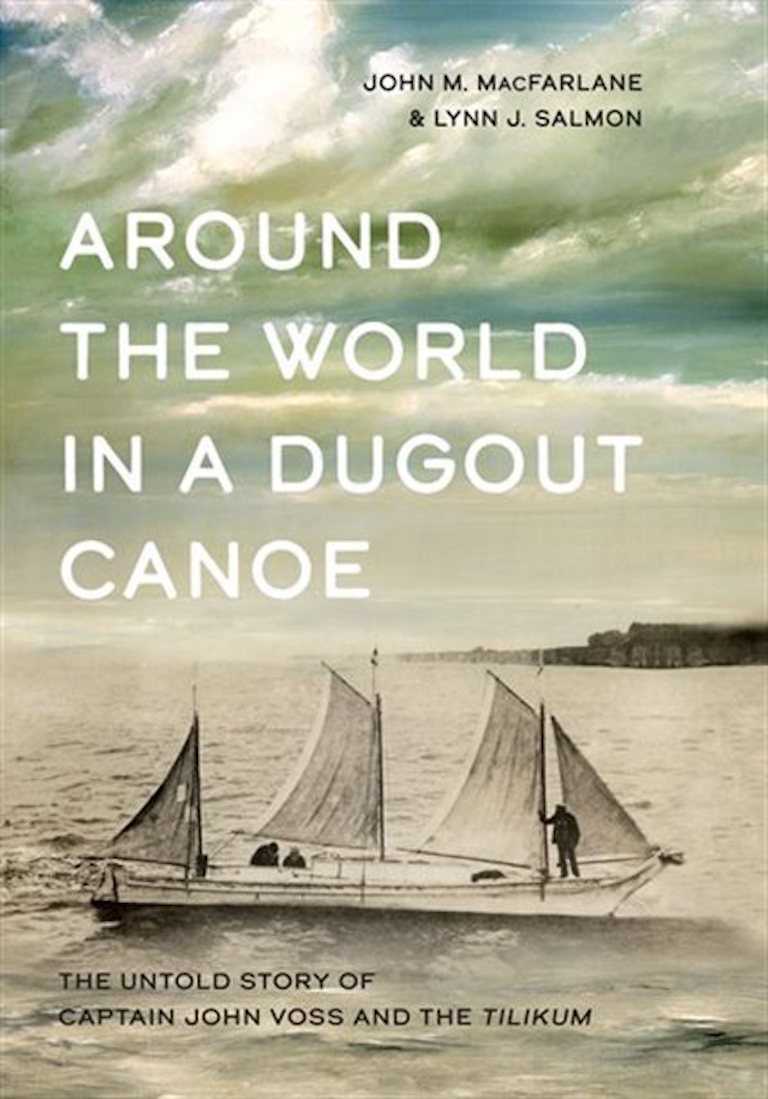Around the World in a Dugout Canoe

Around the World in a Dugout Canoe: The Untold Story of Captain John Voss and the Tilikum
by John M. MacFarlane and Lynn J. Salmon
Harbour Publishing,
268 pages, $29.95
I first heard about John Voss and the Tilikum while working as an interpretive guide at the Whyte Museum of the Canadian Rockies in Banff, Alberta. As part of a walking tour of Banff, we would visit the historic Luxton Home on Beaver Street, where I would regale tourists with a tale of two men sailing across the Pacific Ocean in a dugout canoe in 1901.
The story went that Norman Luxton, a newspaperman originally from Winnipeg, met John Voss, a Danish-born Canadian mariner, at a bar in Victoria, B.C. Over drinks, they hatched a scheme to purchase a Nuu-chah-nulth whaling canoe, outfit it with sails, and circumnavigate the globe. While they were in the South Pacific, Luxton fell overboard.
To protect himself in shark-infested waters, Luxton held on to a piece of coral reef for hours, leaving him battered, bruised, and suffering from coral poisoning (the result of exposure to a dangerous toxin). On the advice of a doctor, Luxton backed out of the rest of the journey, found a replacement mate for Voss, and returned home to Canada.
More often than not, after my presentation, someone would ask, “But what happened to John Voss? Did he finish the journey?” My response was limited; I knew that Voss made it to London, England, but I had also read about rumours of drunken fights, cannibalism, and murder.
John M. MacFarlane and Lynn J. Salmon’s recent book, Around the World in a Dugout Canoe, tackles these questions head-on. They trace Voss’s journey as he attempted the world record for the smallest vessel ever to circumnavigate the globe.
Both of the authors are nautical scholars associated with the Maritime Museum of British Columbia. In their book, MacFarlane and Salmon bypass the jargon associated with seafaring to create an exciting tale of courage and adventure. They provide a detailed account of the Tilikum’s route and share colourful stories about Voss and his companions.
Reading episodes ranging from the dangers of colliding with other vessels, to weathering heavy gales at sea, to the occasional need for a “Colman’s mustard emetic,” it becomes clear that the three-and-a-half-year journey was both exhilarating and exhausting.
Around the World in a Dugout Canoe shines in its dismantling of the rumours and misinformation that have been associated with the story of the Tilikum. Both Voss and Luxton wrote their own accounts of the journey, and their accounts differed on many points.
Luxton’s version, in particular, is rife with accusations and assumptions. Most notably, he suggests that Voss murdered the man who replaced him in the voyage. As explained by MacFarlane, this accusation has tainted the story and “been poisonously repeated by bloggers over the years without any substantiation.”
In Around the World in a Dugout Canoe, the authors have unravelled Voss’s and Luxton’s competing accounts, comparing them to research from museums, libraries, and archives around the world. In doing so, they not only provide the first independent account of the journey but also a critical examination of the two people inextricably linked with the voyage.
MacFarlane and Salmon are able to make compelling conclusions based on corroborating independent evidence, their in-depth knowledge of seamanship, and their understanding of the personalities involved.
Supplemented with archival photographs, letters, and newspaper articles, Around the World in a Dugout Canoe is a lively read that provides an up-close portrait of Voss, whom the authors call “one of the greatest small-craft sailors of all time.” They also come to their own conclusion regarding whether there was in fact a murder on the Tilikum.
Themes associated with this article
Advertisement




